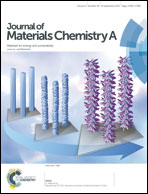Hierarchical mesoporous/macroporous Co3O4 ultrathin nanosheets as free-standing catalysts for rechargeable lithium–oxygen batteries†
Abstract
Hierarchical mesoporous/macroporous Co3O4 ultrathin nanosheets were synthesized as free-standing catalysts for rechargeable Li–O2 batteries. The Co3O4 nanosheets were directly grown on nickel foam through a simple hydrothermal reaction, followed by a calcination process. The impact of solvents used in the hydrothermal reaction on the morphology of catalysts has been investigated. The results showed that the prepared Co3O4 catalyst synthesized with ethylene glycol and deionized water (1 : 1 in volume) presented a much better electrochemical performance with a capacity of 11 882 mA h g−1 under a current density of 100 mA g−1 during the initial discharge and good cycling stability (more than 80 cycles at 200 mA g−1 with the capacity limited to 500 mA h g−1). Meanwhile, the charge potential was significantly reduced to ca. 3.7 V. It is interesting to find that the morphology of the discharge product, Li2O2 could be changed by controlling the shape of catalysts. The impacts of the hierarchical mesoporous/macroporous nanosheet structure on the performance of Li–O2 batteries have been discussed.



 Please wait while we load your content...
Please wait while we load your content...